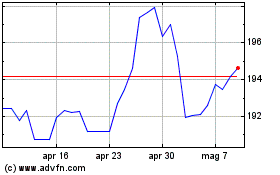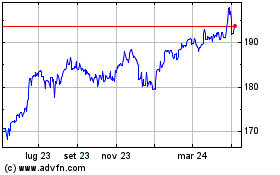Pound Climbs Amid Risk Appetite
01 Febbraio 2018 - 6:50AM
RTTF2
The pound strengthened against its major counterparts in early
European deals on Thursday amid risk appetite, as banking shares
rallied after the U.S. Federal Reserve left its key rate unchanged,
as widely expected, but set the stage for a rate hike at its next
meeting in March.
The Fed acknowledged stronger growth and indicated confidence
about inflation, warranting case for "further gradual" rate
hikes.
Solid factory data from the euro area underpinned risk
sentiment.
Survey data from IHS Markit showed that Eurozone manufacturing
activity expanded markedly at the start of the year, driven by
solid expansions of both production and new orders.
The final factory Purchasing Managers' Index dropped to a
three-month low of 59.6 in January from December's record high of
60.6.
Data from the IHS Markit/CIPS showed that UK manufacturing
logged further easing at the start of 2018, falling to its lowest
level since June last year, but sustained its robust momentum.
The manufacturing PMI fell to 55.3 from 56.2 in December.
Economists had predicted a score of 56.5.
In other economic releases, U.K. house price inflation
accelerated to its highest level in 10 months in January, defying
expectations for a slowdown, results of a survey by the Nationwide
Building Society showed.
The house price index rose 3.2 percent year-on-year after a 2.6
percent increase in December. Economists had expected 2.5 percent
gain.
The currency fell against its major rivals in the Asian session,
with the exception of the franc.
The pound advanced to a 6-day high of 1.3301 against the Swiss
franc, from a low of 1.3203 hit at 5:00 pm ET. The next possible
resistance for the pound is seen around the 1.34 area.
Preliminary data from the Federal Statistical Office showed that
Swiss retail sales rose for a second straight month in
December.
Retail sales rose a calendar adjusted 0.6 percent year-on-year
after a 0.3 percent increase in the previous month. In October,
sales fell 2.3 percent.
Having fallen to 1.4160 against the greenback at 2:15 am ET, the
pound firmed to a 6-day high of 1.4275. The pound is seen finding
resistance around the 1.44 level.
The pound rallied to 156.45 against the yen, a level unseen
since June 20, 2016. If the pound rises further, it may target
resistance around the 158.00 region.
The latest survey from Nikkei showed that Japan manufacturing
sector continued to expand in January, and at a faster rate, with a
Manufacturing PMI score of 54.8.
That's up from 54.0 in December, and it moves further above the
boom-or-bust line of 50 that separates expansion from
contraction.
The pound hit a weekly high of 0.8717 against the euro,
following a decline to 0.8757 at 1:30 am ET. On the upside, 0.86 is
possibly seen as the next resistance level for the pound.
Looking ahead, U.S. weekly jobless claims for the week ended
January 27, construction spending for December and ISM
manufacturing index for January are set for release in the New York
session.
Grafico Cross Sterling vs Yen (FX:GBPJPY)
Da Mar 2024 a Apr 2024

Grafico Cross Sterling vs Yen (FX:GBPJPY)
Da Apr 2023 a Apr 2024
